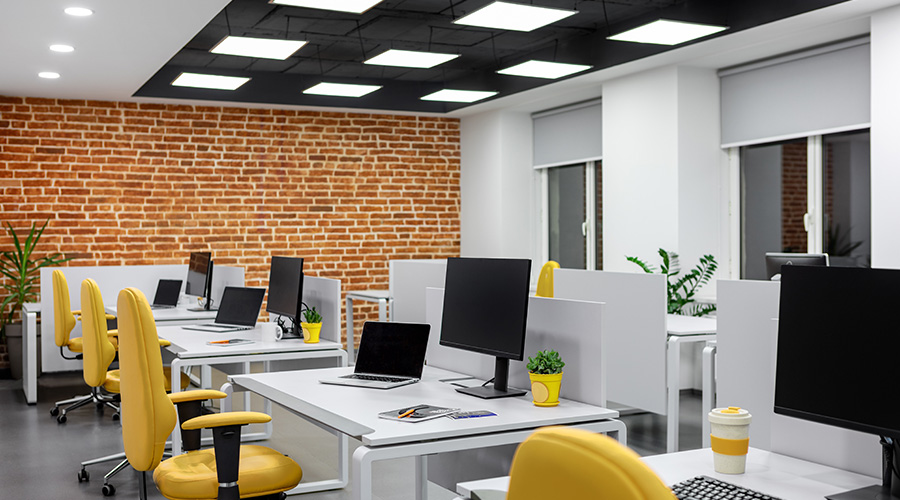Out-of-the-Box Thinking on Systems Furniture
Cubicle. To many, the word itself is emblematic of early ‘90s office space — space that, while effective at accommodating lots of workers and the technology they used, didn’t inspire much more than a few Dilbert punchlines.
Office furniture has come a long way. Today’s systems furniture goes beyond the standard beige cubicle, encompassing a range of products — including wall panels, desks, storage units and more — that are designed to be used together in an open-plan environment. New systems furniture lines reflect modern tastes, with styles that are often architectural or European in inspiration. What’s more, manufacturers have redoubled their efforts to identify and design with an eye toward emerging workplace trends. As a result, the old issues of most concern to manufacturers have given way to new, more end-user-centered priorities.
Focus has shifted, say industry experts, to designing systems that respond to the challenges and opportunities inherent in changing corporate strategies; shifting organizational priorities; and changes in the nature of work itself, such as the rise of teaming and collaboration.
This change is just one example of what Keith McRobert, director of systems product management with Herman Miller, sees as an industry-wide shift beyond basic functionality.
“Most systems products today do a good job of addressing basic facility needs like cable management and so on,” McRobert says. “Now the question is, ‘How can we better meet individual users’ needs?’”
“As an industry, we’re more focused on the type of overall environment that is created for workers,” says Trendway President Mark Groulx.
One way systems furniture manufacturers are working to meet users’ and organizations’ needs is through improvements that enhance comfort and contribute to productivity.
“Our customers are increasingly aware that a facility’s performance cost impact is minimal compared with maximizing the productivity of the people,” says Matt Haworth, systems group manager, product marketing and development, Haworth, Inc. The company’s research indicates that “people” costs — salaries, benefits, etc. — may constitute as much as 82 percent of a typical business’ total expenses.
As a result, newer systems give employees greater control over their own environments, including lighting, temperature and sound. Some systems come with built-in sound-absorption or sound-masking capabilities.
In addition, adjustability gives employees the ability to customize their workstations to accommodate their work habits and preferences, and helps facility executives ensure that workspaces are ergonomically sound. Experts note that, while true “user-reconfigurability” is still a few years off, today’s systems furniture weighs less and is easier to modify than in the past, providing greater flexibility to accommodate workers’ preferences or changing needs.
“Facility executives have told us that they want simplicity,” says Groulx. “That’s one of the things we are working to deliver.”
Systems that combine comfort and space-saving features are especially important as organizations squeeze employees into smaller spaces.
“Many firms have downsized their facilities as a result of the tough economy over the past few years,” says Susan Niemiec, marketing manager, Aurora. “Now we’re seeing an upturn in hiring again. So the question for facilities is, ‘Where do you fit all these people?’”
Newer furniture systems address this issue by combining storage and work surfaces in new ways. With features like overhead storage and file cabinets that stack or essentially tuck into the walls, new systems make the most of space that has gone largely unused.
“Today’s panel systems offer features like personal storage for briefcases, umbrellas, purses and coats,” says Dave Burdakin, President, The HON Company. “Those are space-saving features, but they also make for a less cluttered, more comfortable work area.”
Recruiting Tool?
While workers may not select one employer over another on the basis of office furniture alone, the right system can be an important tool in creating a work environment that appeals to younger workers. That task, say experts, means combining an efficient, often compact floorplan with amenities that reduce a worker’s sense of being trapped in an impersonal cubicle. Key to this task: achieving balance between privacy and collaboration.
“People used to think teaming meant that everybody wants to sit real close to each other, but what we’re starting to see is that people want privacy,” says Groulx. “They need to come together when they want to, but that’s not all the time.”
“We’re talking about the anti-Dilbert effect,” says McRobert. “We need to create a workspace that provides a sense of dignity, that allows an employee to remain an individual while being connected to others.”
“You can give people options like the ability to open a panel between workstations when people are working together without deconstructing the entire workstation,” says Tom Barchacky, KI’s systems furniture product manager.
Today’s more flexible furniture systems can also communicate support for younger workers’ nontraditional work styles.
“People will be dictating the terms of their employment more, and we won’t see as many 9-to-5 employees,” says Jan Fasse, senior market research analyst with Allsteel. “An employee may come into the office partway through the day to participate in a collaborative meeting, then spend some time working independently before leaving again a few hours later. Workspaces need to be flexible enough to accommodate that workstyle.”
To that end, many of today’s furniture systems are designed not just to house traditional, 9-to-5 workers, but also to support a hoteling approach in which employees with different schedules share workstations. In this scenario, files and storage must be able to hold and organize multiple employees’ materials and belongings. Computer stations must be designed to readily accommodate laptops, with accessible connections to printers, the company’s network and so on.
“Some of the newer systems offer places to store the technology items that have never really had homes, like Palms and Blackberries,” Fasse says.
Furniture systems can also support recruitment and retention goals — as well as customer relationships — by helping to convey an overall sense of an organization’s culture.
“Furniture can say a lot about whether the organization is more progressive or more conservative, for example,” says McRobert. “It can be an indicator of culture that is evident as soon as someone walks through the door.”
That said, experts caution against expecting a new furniture system to bring about a cultural transformation.
“The great misconception is that if I change my environment my people will change,” says Haworth’s senior interiors developer, David Fik. “More likely, they’ll be out there with pitchforks. Implementing a new system can signal a culture change, but it is not the way to bring it about.”
Keeping Costs in mind
Today’s systems offer more features for the cost-conscious. Many systems offer interconnectivity and universal components, features that are key in reducing the amount of warehouse space that must be devoted to inventory. In addition, simpler reconfigurability not only creates functional flexibility, but also eliminates the expense of restructuring a floorplan to accommodate churn.
“A key area where today’s furniture can add value is in addressing the need of businesses to adapt rapidly to changing markets,” says Matt Haworth. “Companies today are always growing and contracting. You want systems furniture to be like Legos, so you can make changes quickly and easily.”
Manufacturers are increasingly concerned about their products’ sustainability, both in terms of the manufacturing process and the environmental stewardship of the product itself.
“Look for high levels of durability, adaptability and reusability,” says Fik. “All of these factors contribute to a product’s environmental impact, as well as its bottom-line value for a facility.”
On top of all that, manufacturers have been hit hard by the economic downturn of the past few years — by some reports, business is off by as much as 40 percent. This has made for a competitive market in which companies are competing on price, on service and on the extent to which their systems truly address facility executives’ concerns.
“Does this translate to price?” asks HON’s Burdakin. “Definitely. No question.”
“Now is a great time for facility executives to really challenge manufacturers to design to their needs,” says Allsteel’s Fasse.
Abigail Gray is a writer who specializes in facility issues. She is former editor of EducationFM magazine.
Related Topics:











